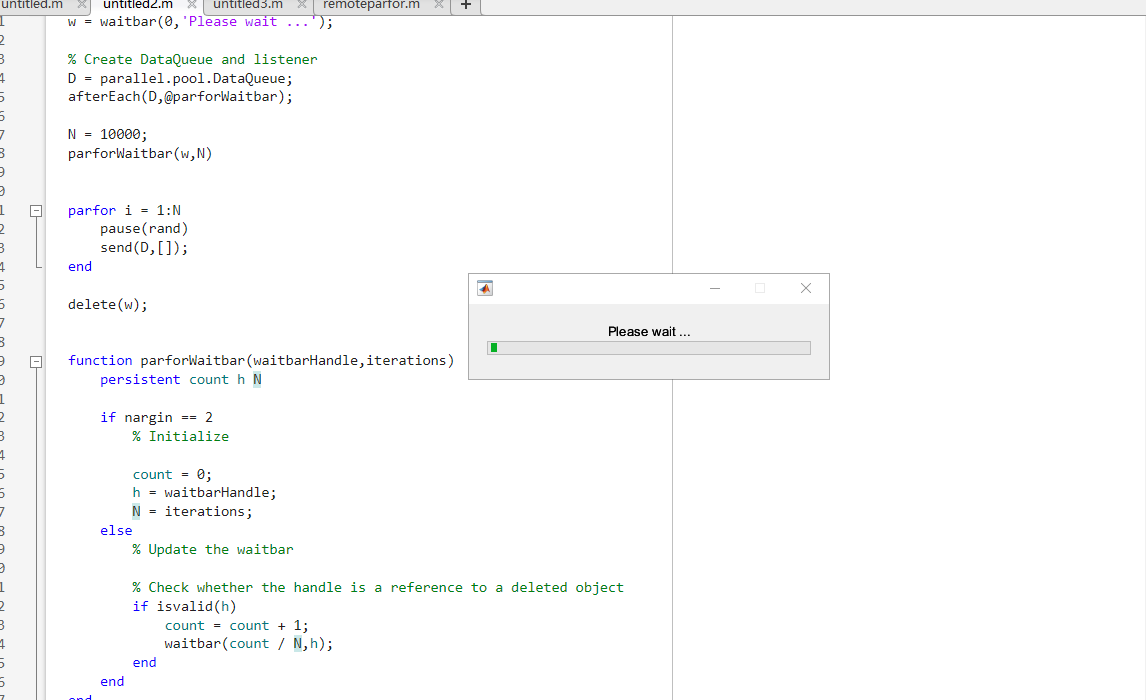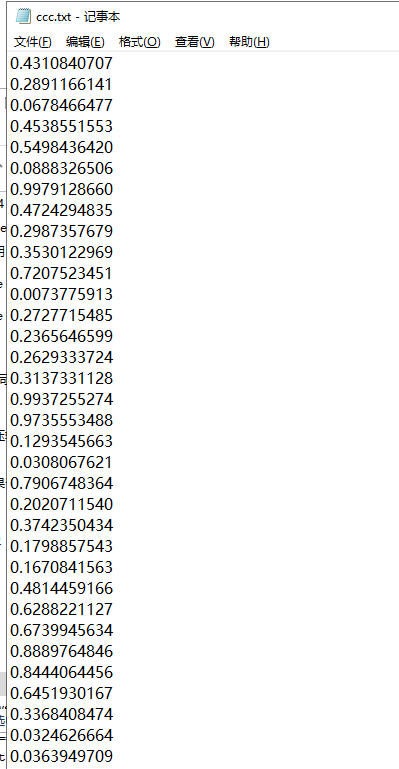做網(wǎng)站顯示上次登錄時間代碼手機(jī)百度搜索app
一. 內(nèi)容簡介
matlab多線程,parfor循環(huán)進(jìn)度,matlab互斥鎖
二. 軟件環(huán)境
2.1 matlab 2022b
2.2代碼鏈接
https://gitee.com/JJW_1601897441/csdn
三.主要流程
3.1 matlab多線程
有好幾種,最簡單的,最好理解的就是parfor,就拿那個為例子了,使用情況就是每一個for循環(huán)之前不能依賴關(guān)系,每輪計算都是獨(dú)立的這種,才可以用parfor,不同版本不太一樣,老版限制好像更多一些
parfor i = 1:1000disp(i);
end

3.2 parfor循環(huán)進(jìn)度
用parfor并行去算一些東西的時候,有些需要循環(huán)很多次,我們是不清楚程序到底執(zhí)行了多少輪,如果可以看到進(jìn)度的話,時間太長了,我們或許就不會算了,
3.2.1 進(jìn)度條窗口方式
會用就行,可以直接拷貝走,這個是官方文檔里面找的
w = waitbar(0,'Please wait ...');% Create DataQueue and listener
D = parallel.pool.DataQueue;
afterEach(D,@parforWaitbar);N = 10000;
parforWaitbar(w,N)parfor i = 1:N% pause替換乘自己的就可以了pause(rand)send(D,[]);
end
delete(w);function parforWaitbar(waitbarHandle,iterations)persistent count h Nif nargin == 2% Initializecount = 0;h = waitbarHandle;N = iterations;else% Update the waitbar% Check whether the handle is a reference to a deleted objectif isvalid(h)count = count + 1;waitbar(count / N,h);endend
end

3.2.2 底部進(jìn)度條方式
會用就行,也是官方網(wǎng)站里面找的,這個還需要一個文件,放到同一級目錄就可以了,代碼我放上邊鏈接了
% 設(shè)置循環(huán)次數(shù)
N = 10000;
% 創(chuàng)建一個迭代計數(shù)器對象
parfor_progress(N);
parfor i = 1:N% pause替換乘自己的就可以了pause(rand)parfor_progress;
end
parfor_progress(0);

3.3 matlab互斥鎖
在parfor循環(huán)中,讀寫數(shù)據(jù)是很麻煩的,并行計算就是要計算結(jié)果的,但是parfor中的計算結(jié)果很難接收出來,量少的時候,還可以通過數(shù)組接收(2016版不可以),量多的時候,數(shù)組接收就不太現(xiàn)實(shí),每輪循環(huán)把數(shù)據(jù)寫入文件中呢,parfor會報錯,即使可以的話,由于matlab沒有互斥鎖,寫文件即使可以寫進(jìn)去,也會是亂的,沒辦法用
還是那句話,會用就行,替換成自己的就可以了,注釋寫里面了
% 創(chuàng)建一個 DataQueue 對象
dq = parallel.pool.DataQueue;
file = fopen('ccc.txt','w');% 多重匿名函數(shù)
fun_with_params = @(data) saveData(data, file);
% 在 DataQueue 上設(shè)置 afterEach 方法,
% 這個是給數(shù)據(jù)綁定一個處理方法,就是在信號發(fā)送以后,執(zhí)行那個處理方法,
% 這個處理方法不是并行的,同一時刻只有一個線程在處理數(shù)據(jù),其他的線程都要排隊
% 和互斥鎖的思想很像
afterEach(dq, fun_with_params);
% 在工作線程中定義處理函數(shù)并發(fā)送數(shù)據(jù)到 DataQueue
parfor i = 1:100% 替換成自己的a = rand();% 在這里通過 send 函數(shù)將數(shù)據(jù)發(fā)送到 DataQueue% 可以發(fā)送單個,也可也發(fā)送數(shù)組send(dq, a);
endfclose(file);function saveData(data, file)% 在此處編寫后處理代碼fprintf(file,'%.10f ', data); fprintf(file,'\n');
end
3.4 parfor_progress.m
function percent = parfor_progress(N)
%PARFOR_PROGRESS Progress monitor (progress bar) that works with parfor.
% PARFOR_PROGRESS works by creating a file called parfor_progress.txt in
% your working directory, and then keeping track of the parfor loop's
% progress within that file. This workaround is necessary because parfor
% workers cannot communicate with one another so there is no simple way
% to know which iterations have finished and which haven't.
%
% PARFOR_PROGRESS(N) initializes the progress monitor for a set of N
% upcoming calculations.
%
% PARFOR_PROGRESS updates the progress inside your parfor loop and
% displays an updated progress bar.
%
% PARFOR_PROGRESS(0) deletes parfor_progress.txt and finalizes progress
% bar.
%
% To suppress output from any of these functions, just ask for a return
% variable from the function calls, like PERCENT = PARFOR_PROGRESS which
% returns the percentage of completion.
%
% Example:
%
% N = 100;
% parfor_progress(N);
% parfor i=1:N
% pause(rand); % Replace with real code
% parfor_progress;
% end
% parfor_progress(0);
%
% See also PARFOR.% By Jeremy Scheff - jdscheff@gmail.com - http://www.jeremyscheff.com/error(nargchk(0, 1, nargin, 'struct'));if nargin < 1N = -1;
endpercent = 0;
w = 50; % Width of progress barif N > 0f = fopen('parfor_progress.txt', 'w');if f<0error('Do you have write permissions for %s?', pwd);endfprintf(f, '%d\n', N); % Save N at the top of progress.txtfclose(f);if nargout == 0disp([' 0%[>', repmat(' ', 1, w), ']']);end
elseif N == 0delete('parfor_progress.txt');percent = 100;if nargout == 0disp([repmat(char(8), 1, (w+9)), char(10), '100%[', repmat('=', 1, w+1), ']']);end
elseif ~exist('parfor_progress.txt', 'file')error('parfor_progress.txt not found. Run PARFOR_PROGRESS(N) before PARFOR_PROGRESS to initialize parfor_progress.txt.');endf = fopen('parfor_progress.txt', 'a');fprintf(f, '1\n');fclose(f);f = fopen('parfor_progress.txt', 'r');progress = fscanf(f, '%d');fclose(f);percent = (length(progress)-1)/progress(1)*100;if nargout == 0perc = sprintf('%3.0f%%', percent); % 4 characters wide, percentagedisp([repmat(char(8), 1, (w+9)), char(10), perc, '[', repmat('=', 1, round(percent*w/100)), '>', repmat(' ', 1, w - round(percent*w/100)), ']']);end
end3.5 補(bǔ)充
按下面代碼執(zhí)行的,afterEach只能保證傳完數(shù)據(jù)以后執(zhí)行對應(yīng)函數(shù),并不代表一個循環(huán)里面的都一起執(zhí)行的

% 創(chuàng)建一個 DataQueue 對象
dq1 = parallel.pool.DataQueue;
dq2 = parallel.pool.DataQueue;
file1 = fopen('ccc1.txt','w');
file2 = fopen('ccc2.txt','w');
% 多重匿名函數(shù)
fun_with_params1 = @(data) saveData(data, file1);
fun_with_params2 = @(data) saveData(data, file2);
% 在 DataQueue 上設(shè)置 afterEach 方法
afterEach(dq1, fun_with_params1);
afterEach(dq2, fun_with_params2);
% 在工作線程中定義處理函數(shù)并發(fā)送數(shù)據(jù)到 DataQueue
parfor i = 1:1000% 替換成自己的a = rand();% 在這里通過 send 函數(shù)將數(shù)據(jù)發(fā)送到 DataQueue% 可以發(fā)送單個,也可也發(fā)送數(shù)組send(dq1, a);send(dq2, a);
end% 等待所有數(shù)據(jù)接收完成% 顯示接收到的數(shù)據(jù)
% 輔助函數(shù)用于保存接收到的數(shù)據(jù)到數(shù)組
function saveData(data, file)% 在此處編寫后處理代碼fprintf(file,'%.10f ', data); fprintf(file,'\n');
end改進(jìn)
% 創(chuàng)建一個 DataQueue 對象
dq1 = parallel.pool.DataQueue;
file1 = fopen('ccc11.txt','w');
file2 = fopen('ccc21.txt','w');
file3 = fopen('ccc31.txt','w');
% 多重匿名函數(shù)
fun_with_params1 = @(data1) saveData(data1, file1, file2,file3);
% 在 DataQueue 上設(shè)置 afterEach 方法
afterEach(dq1, fun_with_params1);
% 在工作線程中定義處理函數(shù)并發(fā)送數(shù)據(jù)到 DataQueue
parfor i = 1:100% 替換成自己的a = rand();data = {i,i,i}% 在這里通過 send 函數(shù)將數(shù)據(jù)發(fā)送到 DataQueue% 可以發(fā)送單個,也可也發(fā)送數(shù)組send(dq1, data);
end% 等待所有數(shù)據(jù)接收完成fclose(file1);
fclose(file2);
fclose(file3);
% 顯示接收到的數(shù)據(jù)
% 輔助函數(shù)用于保存接收到的數(shù)據(jù)到數(shù)組
function saveData(data, file1,file2,file3)% 在此處編寫后處理代碼data1 = data{1};data2 = data{2};data3 = data{1};fprintf(file1,'%.10f ', data1); fprintf(file1,'\n'); fprintf(file2,'%.10f ', data2);fprintf(file2,'\n'); fprintf(file3,'%.10f ', data3);fprintf(file3,'\n');
end